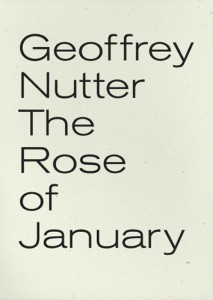What We’re Reading: The Rose of January

 The Rose of January by Geoffrey Nutter (Wave Books; 2013)
The Rose of January by Geoffrey Nutter (Wave Books; 2013)
Geoffrey Nutter’s fourth collection The Rose of January is a wonderful, if occasionally overwrought, collection of poems that shows Nutter at his most verbally dexterous. The poems here are borderline maximalist compared to some of Nutter’s earlier work, notably his debut collection, A Summer Evening (Center for Literary Publishing, 2001). Nutter stretches the content of these poems, sustaining feeling across multiple pages, delivering a consistently surprising, if not always consistent, read.
Nutter is at his best when he moves from a simple statement or image into a complex web of words. In these moments, it seems Nutter tries to synthesize the concrete images of William Carlos Williams with the abstract virtuosity of Wallace Stevens. “Metalmark,” the first poem in the collection, begins:
Last night I dreamed
a giant butterfly,
its enormous wings striped
with myriad colors,
was drifting silently
over the green hills
and above the bridges
and the towers of the city.
It was not akin
to a flowered matrix
of calculated vernal
arrangements, nor the yellow
undulation of a wave
seen by a child at eventide.
The poem goes on to liken the butterfly to marble blocks and stones from a mill. In many of the poems, the initial image—here, a giant butterfly flying over a city—explodes into vibrant colors as Nutter vividly captures his subject, and then shifts to his true focus. “Metalmark” ends, “[…] that I beheld it from the sky / was what the dream made / not probable, but possible.” Elsewhere in the book, Nutter applies his verbal fireworks to literal fireworks in a longer poem called “Fireworks Display in Early Summer:”
From the crumbling parapets
that overlook the highway and waterway
we were stirred to a kind of wakefulness
and saw them exploding, staving off the increase
of night’s aloe-bladed debtors, lifting lights
skyward for love and augury’s igniting.
The poem continues for 13 more 9-line stanzas that range widely, but never waver from the heightened awareness of the earth and sky that comes from being outside watching fireworks.
Nutter does poke a little fun at his own loquaciousness, as in “Dope” that comes early in the collection. The language is heightened for comedic effect, using the word dope 16 times including the title, ultimately rendering the word almost meaningless. The poem begins, “I don’t mean to be pugnacious / but your bones are made of dope—” before going on to declare blood, quince, and statues to also be made of dope.
You live in a mansion, El Dorado,
and your mansion with its five bay windows
turned toward the bay is builded of dope
and the bay is dope, and the bodies underneath
your house turn goldener as gold doth dopeth.
While most of The Rose of January is successfully energetic and satisfying yet abstract, there are several duds. Poems such as “Invective Against Pugs” and “Remember the Telephone Book” apply Nutter’s dense verbiage to subjects that fail to satisfy. While many of the poems here make surprising observations about simple things, occasionally the subject simply cannot sustain the weight of Nutter’s language.
Overall, Nutter’s fourth collection is a satisfying outing, applying Stevens’ abstract language to more contemporary subjects, linking the early 20th-century to the early 21st-century in unexpected and delightful ways. Stevens’ influence is apparent, but Nutter distinguishes himself, using humor and irony to keep the earnestness from crushing the reader in sentiment.
What other writers take their influences and update and change them? Is it successful, or does it come across as pastiche?





